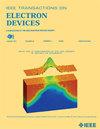Space Charge Effects on Short-Pulse Electron Beam Dynamics in a Classical Vacuum Diode
IF 2.9
2区 工程技术
Q2 ENGINEERING, ELECTRICAL & ELECTRONIC
引用次数: 0
Abstract
Space charge effects pose significant challenges to the advancement of electron beam-based technologies. In this study, we investigate the influence of space charge effects on the evolution of short-pulse beam profiles in a vacuum diode using a 1-D multiple-sheet model and 2-D particle-in-cell (PIC) simulations. The effects of different initial profiles (square-top, trapezoidal, or Gaussian), charge densities, and pulse widths are analyzed. We examine the current density limit as the pulselength decreases and the resulting distortion of the beam as it traverses the gap. It is found that for the same total charge, square-top, trapezoidal, and Gaussian pulses undergo similar degree of distortion, where Gaussian pulses show slightly larger distortion (especially at longer pulselength and smaller charge density) due to its wider spread in shape. The distortion becomes more significant for shorter pulselength. For larger charges in the pulse, the tail of the pulse travels through the gap at a decelerated rate. A shorter pulse duration also leads to a larger beam energy spread for all three pulse profiles, with the peak electron densities found at low and high energy ends of the distribution. For longer pulses, the density peaks are at the center of the energy distribution. In addition, the maximum current density that can be transported across the diode follows the short-pulse Child-Langmuir (CL) law, regardless of the initial pulse shape. The results from the multiple-sheet model are in good agreement with PIC simulations.经典真空二极管短脉冲电子束动力学中的空间电荷效应
空间电荷效应对电子束技术的发展提出了重大挑战。在这项研究中,我们利用一维多片模型和二维粒子池(PIC)模拟研究了空间电荷效应对真空二极管中短脉冲光束分布演变的影响。分析了不同初始轮廓(方顶、梯形或高斯)、电荷密度和脉冲宽度的影响。我们研究了当脉冲长度减小时的电流密度极限,以及当光束穿过间隙时产生的畸变。研究发现,对于相同的总电荷,方顶脉冲、梯形脉冲和高斯脉冲的畸变程度相似,其中高斯脉冲由于其形状分布更广,畸变程度略大(特别是在较长的脉冲长度和较小的电荷密度下)。脉冲长度越短,畸变越明显。对于脉冲中较大的电荷,脉冲的尾部以减速的速度穿过间隙。较短的脉冲持续时间也导致所有三种脉冲剖面的更大的光束能量扩散,在分布的低能和高能端发现峰值电子密度。对于较长的脉冲,密度峰位于能量分布的中心。此外,无论初始脉冲形状如何,可以通过二极管传输的最大电流密度遵循短脉冲Child-Langmuir (CL)定律。多片模型的结果与PIC模拟结果吻合较好。
本文章由计算机程序翻译,如有差异,请以英文原文为准。
求助全文
约1分钟内获得全文
求助全文
来源期刊

IEEE Transactions on Electron Devices
工程技术-工程:电子与电气
CiteScore
5.80
自引率
16.10%
发文量
937
审稿时长
3.8 months
期刊介绍:
IEEE Transactions on Electron Devices publishes original and significant contributions relating to the theory, modeling, design, performance and reliability of electron and ion integrated circuit devices and interconnects, involving insulators, metals, organic materials, micro-plasmas, semiconductors, quantum-effect structures, vacuum devices, and emerging materials with applications in bioelectronics, biomedical electronics, computation, communications, displays, microelectromechanics, imaging, micro-actuators, nanoelectronics, optoelectronics, photovoltaics, power ICs and micro-sensors. Tutorial and review papers on these subjects are also published and occasional special issues appear to present a collection of papers which treat particular areas in more depth and breadth.
 求助内容:
求助内容: 应助结果提醒方式:
应助结果提醒方式:


